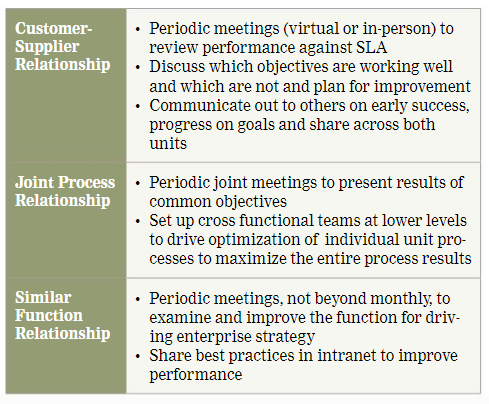Horizontal alignment for strategy execution

A process called ‘’integration’’ is what we have been using over two decades for our clients. Spilling the secrets for the first time for the general public.
Integration enables same-level business units within the total enterprise to coordinate their strategic objectives and support the overall corporate strategy. This alignment will bring in much better overall results than the isolated individual unit performance. The following figure captures the integration concept.

The component-manufacturing division of one of our clients makes parts for its global customers, and its own consumer goods division also uses some of these components. By using the transfer-pricing mechanism, the consumer goods division achieved a competitive advantage in its industry.
Another client, bleeding crores a day, was trying to turn around, and the founder CMD wanted to know from his business heads where the problems were. All of them claimed they were doing their jobs well, leaving the CMD as the only reason for the near-bankruptcy status. We called for a management meeting with all functional and business unit heads along with the founder. The discussions were foused on growth, quality issues, process modifications, and talent development. We added strategy execution as a key focus area. Strategy maps and scorecards became central to all performance meetings.
As a result, the meeting participants turned more objective and less shrugging off responsibilities and started offering assistance to those falling behind in targets. Nothing that happens in a company is the sole responsibility of a single business head is the wisdom we keep giving. Action plan for behind-target units was put together with the help of a cross-member committee, guided by us. Information sharing and team alignment ensured better execution of objectives.
The integration helped the company achieve both collective creative problem solving skills and teamwork culture. Cross-functional and cross-business integration of people ensured faster turnaround. Boundary-less working beyond the defined organization structure turned out to be most useful.
As in cascading for vertical alignment, integration follows a similar four-stage process, viz., defining the organizational position, developing an action plan, applying techniques, and finally, sustaining the efforts of integration.
Stage 1: What's your organizational relationship position?
Identify which business and functional units are at the same level as your own unit and where all you interact. Also decide on what relationships you have with other units from the three possibilities – Customer/supplier, joint processes, or similar function?
As an example of customer/supplier position, the IT department provides system and other technology support to a business unit. The two scorecards of the two units share objectives reflecting this horizontally aligned relationship. The IT scorecard objectives may include "Equip employees with CRM system skills” and the SBU scorecard objectives may include "Improve cross sales e”, for instance.
Many units jointly hold responsibility for functions such as supply chain. The supply chain group unit's scorecard objectives reflect this integrated relationship. Purchasing unit wants to "minimize order inaccuracy", Stores department aims for "just-in-time inventory", distribution folks want to “improve on-time deliveries”, and so on.
The third position of a similar function is something like HR teams within different business units of an enterprise. Each of them should have scorecards that would be similar, and objectives and even measurements will be the same. Targets of course will vary.
Stage 2: What's your action plan?
Any action plan must include details on accountability, sequence, and scope. Answering the following questions will get you to the action plan.
Who will be responsible for deciding on the same level units, and who will take a call on which ones to be aligned and when? Who is responsible for implementing the integration? Whether one should integrate units on a priority basis or can it be done together? Or, should there be a sequential integration?
Should we look at an optimum number of peer business unit relationships for better management? How many will be too many? What could be the resource commitments from each unit? Will it affect the regular work, and if so, in what way?
Stage 3: What techniques to use?
We normally start the integration by discussing with the peer unit leaders on the types of relationships they currently have and what may be ideal for the enterprise strategy. This will then lead to an integration meeting of all relevant unit leaders together.
Based on the type of relationship, identify goals for the integration meetings. For instance, if there is a customer-supplier relationship between two units, we normally develop a service-level agreement (SLA) that specifies each unit’s deliverables. A good SLA will have objectives that support the “customer” needs and the larger enterprise strategy, a framework that will promote dialogue, and it will enable the prioritization of objectives and support requests. Many organizations that have SLAs fail to execute them well because they don’t hold periodic joint meetings to ensure that customer service as per expectations set, don’t focus on the critical objectives that drive performance of both units, or don’t use the same measures to define success.
If two business units have joint process ownership, we push all participants to commit to the same. We also map their contributions to the joint process by specifying each unit’s input and output from the process. During the integration meeting, in this case, ensure maximum performance across the entire process instead of optimizing some parts of the process amongst some units. We have seen resistance from unit leaders as they push for altering intermediate process targets for an optimization of the overall results. This should not be allowed. Also, remove redundant activities from the various units.

When two or more units have similar function relationship, we force them to learn from each other for identifying best practices. We recommend common metrics to benchmark performances. This also triggers best practice sharing across units.
Stage 4: How to sustain the integration?
Sustenance is all about communicating with peer units about the integration efforts and sharing early successes thereof. Depending on the type of relationship, the above table outlines the type of communication appropriate.
With integration comes alignment of peer units and this has a significant impact on strategic objectives of the enterprise. With this, organizations can eliminate the perennial finger-pointing between peer units when performance is below par.
As in cascading for vertical alignment, integration follows a similar four-stage process, viz., defining the organizational position, developing an action plan, applying techniques, and finally, sustaining the efforts of integration
We normally start the integration by discussing with the peer unit leaders on the types of relationships they currently have and what may be ideal for the enterprise strategy. This will then lead to an integration meeting of all relevant unit leaders together















